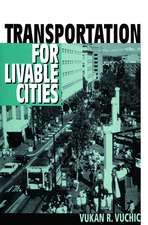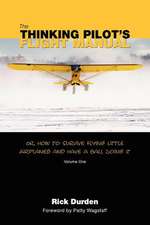Stick and Rudder: An Explanation of the Art of Flying
Autor Wolfgang Langewiescheen Limba Engleză Hardback – 16 ian 1944
WHAT'S IN STICK AND RUDDER:
- The invisible secret of all heavier-than-air flight: the Angle of Attack. What it is, and why it can't be seen. How lift is made, and what the pilot has to do with it.
- Why airplanes stall How do you know you're about to stall?
- The landing approach. How the pilot's eye functions in judging the approach.
- The visual clues by which an experienced pilot unconsciously judges: how you can quickly learn to use them.
- "The Spot that does not move." This is the first statement of this phenomenon. A foolproof method of making a landing approach across pole lines and trees.
- The elevator and the throttle. One controls the speed, the other controls climb and descent. Which is which?
- The paradox of the glide. By pointing the nose down less steeply, you descend more steeply. By pointing the nose down more steeply, you can glide further.
- What's the rudder for? The rudder does NOT turn the airplane the way a boat's rudder turns the boat. Then what does it do?
- How a turn is flown. The role of ailerons, rudder, and elevator in making a turn.
- The landing--how it's made. The visual clues that tell you where the ground is.
- The "tail-dragger" landing gear and what's tricky about it. This is probably the only analysis of tail-draggers now available to those who want to fly one.
- The tricycle landing gear and what's so good about it. A strong advocacy of the tricycle gear written at a time when almost all civil airplanes were taildraggers.
- Why the airplane doesn't feel the wind.
- Why the airplane usually flies a little sidewise.
- Plus: a chapter on Air Accidents by Leighton Collins, founder and editor of AIR FACTS. His analyses of aviation's safety problems have deeply influenced pilots and aeronautical engineers and have contributed to the benign characteristics of today's airplane.
Because the basics are largely unchanging, the book therefore is applicable to large airplanes and small, old airplanes and new, and is of interest not only to the learner but also to the accomplished pilot and to the instructor himself.
When Stick and Rudder first came out, some of its contents were considered highly controversial. In recent years its formulations have become widely accepted. Pilots and flight instructors have found that the book works.
Today several excellent manuals offer the pilot accurate and valuable technical information. But Stick and Rudder remains the leading think-book on the art of flying. One thorough reading of it is the equivalent of many hours of practice.
Preț: 181.51 lei
Nou
Puncte Express: 272
Preț estimativ în valută:
34.73€ • 36.26$ • 28.74£
34.73€ • 36.26$ • 28.74£
Carte disponibilă
Livrare economică 15-29 martie
Livrare express 01-07 martie pentru 37.22 lei
Preluare comenzi: 021 569.72.76
Specificații
ISBN-13: 9780070362406
ISBN-10: 0070362408
Pagini: 400
Dimensiuni: 150 x 224 x 22 mm
Greutate: 0.66 kg
Ediția:70
Editura: McGraw Hill Education
Colecția McGraw-Hill
Locul publicării:United States
ISBN-10: 0070362408
Pagini: 400
Dimensiuni: 150 x 224 x 22 mm
Greutate: 0.66 kg
Ediția:70
Editura: McGraw Hill Education
Colecția McGraw-Hill
Locul publicării:United States
Cuprins
PART I: WINGS
Chapter 1: How a Wing is Flown
Chapter 2: The Airplane's GaitsChapter 3: Lift and Buoyancy
Chapter 4: The Flying InstinctPART II: SOME AIR SENSE
Chapter 5: The Law of the Roller Coaster
Chapter 6: Wind DriftChapter 7: What the Airplane Wants to Do
Chapter 8: That Thing Called TorquePART III: THE CONTROLS
Chapter 9: The Flippers and the Throttle
Chapter 10: The AileronsChapter 11: The Rudder
PART IV: THE BASIC MANEUVERS
Chapter 12: The Turn
Chapter 13: Straight and Level CruisingChapter 14: The Glide
PART V: GETTING DOWN
Chapter 15: The Approach
Chapter 16: The LandingChapter 17: The Landing Run
PART VI: THE DANGERS OF THE AIR
Chapter 18: The Dangers of the Air
PART VII: SOME MORE AIR SENSE
Chapter 19: The Working Speeds of an Airplane
Chapter 20: Thin AirDescriere
"The Spot that does not move." This is the first statement of this phenomenon. A foolproof method of making a landing approach across pole lines and trees. The elevator and the throttle.
One controls the speed, the other controls climb and descent. Which is which? The paradox of the glide. By pointing the nose down less steeply, you descend more steeply.
By pointing the nose down more steeply, you can glide further. What's the rudder for? The rudder does NOT turn the airplane the way a boat's rudder turns the boat. Then what does it do? How a turn is flown.
The role of ailerons, rudder, and elevator in making a turn. The landing--how it's made. The visual clues that tell you where the ground is.
The "tail-dragger" landing gear and what's tricky about it. This is probably the only analysis of tail-draggers now available to those who want to fly one. The tricycle landing gear and what's so good about it.
A strong advocacy of the tricycle gear written at a time when almost all civil airplanes were taildraggers. Why the airplane doesn't feel the wind. Why the airplane usually flies a little sidewise.
Plus: a chapter on Air Accidents by Leighton Collins, founder and editor of AIR FACTS. His analyses of aviation's safety problems have deeply influenced pilots and aeronautical engineers and have contributed to the benign characteristics of today's airplane. Stick and Rudder is the first exact analysis of the art of flying ever attempted.
It has been continously in print for thirty-three years. It shows precisely what the pilot does when he flies, just how he does it, and why. Because the basics are largely unchanging, the book therefore is applicable to large airplanes and small, old airplanes and new, and is of interest not only to the learner but also to the accomplished pilot and to the instructor himself.
When Stick and Rudder first came out, some of its contents were considered highly controversial. In recent years its formulations have become widely accepted. Pilots and flight instructors have found that the book works.
Today several excellent manuals offer the pilot accurate and valuable technical information. But Stick and Rudder remains the leading think-book on the art of flying. One thorough reading of it is the equivalent of many hours of practice.













